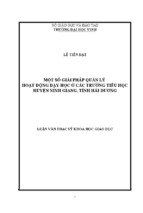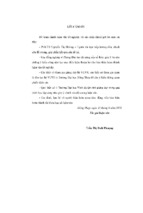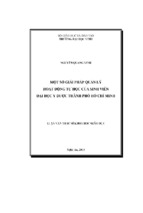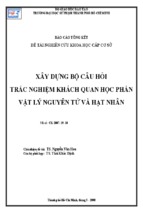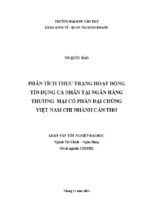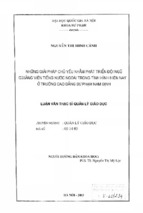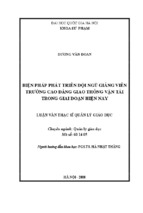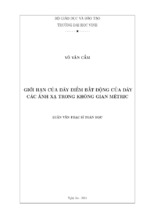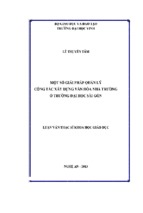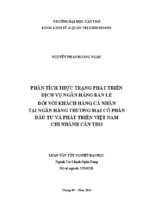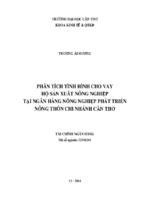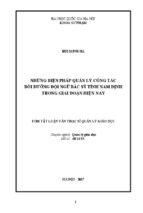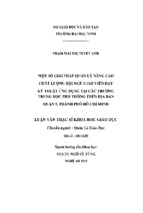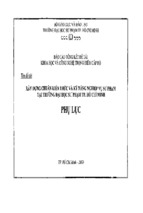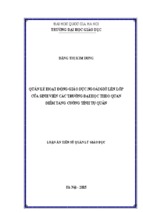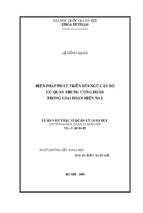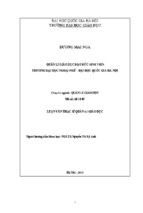Tài liu lun vn s phm , giáo dc1 of 63.
HANOI PEDAGOGICAL UNIVERSITY 2
FACULTY OF FOREIGN LANGUAGES
BUI THI YEN
A STUDY ON SOME MAJOR FACTORS AFFECTING STUDENTS’
INTEREST IN LEARNING ENGLISH AT A HIGH SCHOOL
IN VIET NAM.
(Graduation paper submitted in partial fulfillment of the Degree of Bachelor of
Arts in English)
Major: English Language Teaching
Hanoi, 2019
Footer Page 1 of 63.
Tài liu lun vn s phm , giáo dc2 of 63.
HANOI PEDAGOGICAL UNIVERSITY 2
FACULTY OF FOREIGN LANGUAGES
BUI THI YEN
A STUDY ON SOME MAJOR FACTORS AFFECTING STUDENTS’
INTEREST IN LEARNING ENGLISH AT A HIGH SCHOOL
IN VIET NAM.
Major: English Language Teaching
SUPERVISOR: TRAN THI MINH PHUONG, MA.
Hanoi, 2019
Footer Page 2 of 63.
Tài liu lun vn s phm , giáo dc3 of 63.
ACKNOWLEDGEMENTS
I am deeply indebted to a number of people and organizations for helping me
make the present thesis possible.
Firstly, I would like to express my deep gratitude to my supervisor, Ms Tran
Thi Minh Phuong. She is very enthusiastic to give me the strong encouragemement
,valuable suggestions for the problems that I had during the process of doing
research. Without her constructive advice and feedback, this research would not
have been completed.
Secondly, I am grateful to all the lectures at Ha Noi Pedagogical University
2, especially the lectures at Faculty of
Foreign Languages for their help and
support.
I also owe my special thanks to the participants at Quynh Coi High School
who helped me doing my surveys and cooperated with me. If I had had no their
support, I would not have completed the research on time.
Last but not least, I would like to express my heartfelt thanks to my parents,
close friends with whose inspiration I am able to complete the paper.
i
Footer Page 3 of 63.
Tài liu lun vn s phm , giáo dc4 of 63.
ABSTRACT
Teaching English as a foreign language in Viet Nam is a challenging task for a
teacher. Language learning should be more interesting and enjoyable for learners to
learn. The level of learners’ interest in learning process depends on many factors
controlled by nature or shaped by nurture. The present study aims at investigating
some major factors affecting students’ interest in learning English of 90 students in
grade 10 at Quynh Coi High School. The primary methods of this research were
survey questionnaire, interviews and classroom observation. These findings
indicated that interest in learning English was a significant issue for EFL learning.
Moreover, external factors had more impact on learners’ English language
proficiency level compared to internal ones. Based on the findings of the present
study, some pedagogical implications were suggested to encourage students and
teachers to improve themselves in learning and teaching English.
Keywords: students’ interest, learning English, external factors.
ii
Footer Page 4 of 63.
Tài liu lun vn s phm , giáo dc5 of 63.
STATEMENT OF AUTHORSHIP
Title:
A STUDY ON SOME MAJOR FACTORS AFFECTING STUDENTS’
INTEREST IN LEARNING ENGLISH AT A HIGH SCHOOL IN VIET
NAM.
(Graduation paper submitted in partial fulfillment of the Degree of Bachelor of Arts
in English)
I certify that I have not copied no part in this study from any others’ reports without
acknowledgement and this work is written by my best under instruction from my
supervisor.
Date of submission: May 2019.
Student
Supervisor
Bui Thi Yen
Tran Thi Minh Phuong
iii
Footer Page 5 of 63.
Tài liu lun vn s phm , giáo dc6 of 63.
LIST OF THE TABLES AND FIGURES
Tables:
Table 1: Indicators of students’ Interest (Slameto2003) ............................................7
Table 2. Taxonomies of factors affecting learners. .....................................................9
Table 3. Eb Mahlobo’s classification of factors(1999).............................................10
Table 4: Classroom observation checklist entries. ...................................................25
Table 5: Students’ attitudes towards teacher ............................................................30
Table 6: Students’ attitudes towards textbook. .........................................................31
Table 7: Classification of LLS types by students according to their frequency of use.
...................................................................................................................................32
Figures:
Figure 1 : The students’ most recent English learning results. ................................27
Figure 2: Students’ intrinsic motivation ...................................................................28
Figure 3: Students’ extrinsic motivation ...................................................................29
Figure 4: Classification of LLS types in terms of frequency of use ..........................33
iv
Footer Page 6 of 63.
Tài liu lun vn s phm , giáo dc7 of 63.
LIST OF ABBREVIATIONS
1. EFL: English as a Foreign Language.
2. TESL: Teaching English as a Second Language.
3. SILL: The Strategies Inventory of Language Learning.
4. LLS: Language Learning Strategies.
5. SLA: Second Language Acquisition.
6. ESL: English Second Language.
6. SA: Strongly Agree.
7. A: Agree.
8. U: Uncertain.
9. D: Disagree.
10. SD: Strongly Disagree.
v
Footer Page 7 of 63.
Tài liu lun vn s phm , giáo dc8 of 63.
TABLE OF CONTENTS
PART A: INTRODUCTION ....................................................................................1
1. Rationale .................................................................................................................1
2. Aims of the study and Research questions..............................................................3
2.1. Aims of the study .................................................................................................3
2.2. Research Questions ..............................................................................................3
3. Scope of the study ...................................................................................................3
4. Methods of the study ...............................................................................................3
5. The significance of the study ..................................................................................4
6. Overview of the study .............................................................................................4
PART B: DEVELOPMENT.....................................................................................5
CHAPTER I: THEORETICAL BACKGROUND .....................................................5
1. Theories of Interest .................................................................................................5
1.1. Definitions of Interest ..........................................................................................5
1.2. Indicators of students’ interest .............................................................................6
1.3. The role of interest in learning. ............................................................................7
2. Definitions of language acquisition ........................................................................8
3. Theoretical frameworks of factors affecting students’ interest. ..............................9
3.1. Eb Mahlobo’s classification of factors...............................................................10
3.2. Brown's classification of factors. .......................................................................10
3.3. Pawlak’s classification of factors .......................................................................11
4. Research Framework .............................................................................................12
4.1. School/Classroom context ..................................................................................12
4.1.1. The school’s teaching- learning culture ..........................................................12
4.1.2. The availability and use of educational resources ..........................................13
4.1.3. The influence of the learner- educator ratio ....................................................13
4.1.4. The teacher’s attitudes and skills in teaching English as a second language.
(TESL) .......................................................................................................................15
4.1.4.1. The teacher’s attitudes towards TESL .........................................................15
4.1.4.2 The teacher’s skill for TESL .........................................................................15
vi
Footer Page 8 of 63.
Tài liu lun vn s phm , giáo dc9 of 63.
4.2. Motivation ..........................................................................................................15
4.3. Learner attitudes .................................................................................................18
4.3.1. Attitude towards teacher .................................................................................18
4.3.2. Attitude towards textbook. ..............................................................................19
4.4. Language learning strategies ..............................................................................20
CHAPTER II: METHODOLOGY ............................................................................22
1.Participants .............................................................................................................22
2. Data collection ......................................................................................................22
2.1. Survey questionnaire. .........................................................................................22
2.1.1. Reasons for using Questionnaire .....................................................................22
2.1.2. Description of questionnaire. ..........................................................................22
2.2 Interview. ............................................................................................................24
2.2.1. Reasons for using interview. ...........................................................................24
2.2.2. Description of interview. .................................................................................24
2.3. Class observation. ..............................................................................................24
2.3.1. Reasons for using class observation ................................................................24
2.3.2. Description of class observation. ....................................................................25
3.Data collection procedure ......................................................................................25
CHAPTER III: FINDINGS AND DISCUSSION ....................................................27
1. Findings from survey questionnaire. .....................................................................27
1.1. Students’ most recent result of English learning. ..............................................27
1.2.Students’ motivation towards English. ...............................................................28
1.3. Attitude towards teacher ....................................................................................30
1.4. Attitude towards textbook ..................................................................................31
1.5.Language learning strategies ...............................................................................32
2. Findings from interview. .......................................................................................34
3. Findings from the classroom observation. ............................................................36
PART C: CONCLUSION.......................................................................................40
1.Summary of the study ............................................................................................40
2. Implications for teaching.......................................................................................42
3. Limitations of the study ........................................................................................43
vii
Footer Page 9 of 63.
Tài liu lun vn s phm , giáo dc10 of 63.
4. Suggestions for futher study..................................................................................43
REFERENCES ..........................................................................................................44
APPENDIX
viii
Footer Page 10 of 63.
Tài liu lun vn s phm , giáo dc11 of 63.
PART A: INTRODUCTION
1. Rationale
Nowadays, kas kthe kworld khas kbecome kmore kand kmore kclosely kintegrated, k
English kplays kan kimportant krole kin kinternational kcommunication. kAccording kto
k
Crystal k(2003), kthere kare k320-380 kmillion kpeople kwhose kfirst klanguage kis kEnglish
k
and k300-500 kmillion kpeople kwhose ksecond klanguage kis kEnglish. kIt kis kthe
k
language kof ktrade, kscience, ktechnology, ktourism, ksport, kmusic kand kmany kother
k
fields kof klife. kAs ka kresult, kin knon-English-speaking kcountries, kthis klanguage khas
k
become kthe kofficial ksubject kin kcurriculum kat kprimary kschools kto kuniversities kin k
k
the k kpast k kdecades. kFor kthis kreason, kit kis knecessary kto kteach kEnglish kto kstudents
k
as kearly kas kpossible kin korder kto kprepare kthem kto kconfront kthe kmodern kera.
k
In Vietnam, children and adults learn English with different purposes.
Children learn it as compulsory subject at schools and their parents want that.
Students learn English to pass the exams, to study abroad or to access to some of the
country’s best universities. Adults study English in order to communicate with
foreigners, find better job opportunities in the future. In general, in spite of deriving
from various purposes, everyone wants to turn English to become their own
instrument in their lives. Yet, despite its apparent utility as a lingua franca or a
world language (Burutt-Grifler, 2002), and the fact that students must pass final
examinations, many students have failed to learn it successfully. This situation also
applies to the students in many countries, particularly Vietnam, where learning
foreign languages is compulsory in schools.
For many students in Vietnam, especially in high schools, learning English
as a second language is one of the most difficult subjects they have learnt. They kare
experiencing kgreat kchanges kboth kin kpsychology kand kphysiology. kTheir kaffect kwill
k
easily kbe kinfluenced kby kany kfactors. kConsequently, kstudents klose ktheir kinterest
k
quickly kin klearning. kInterest kis kone kof kthe kimportant kaffective kelements kin
k
learning kprocess, kwhich khelps kto kdetermine kthe klevel kof kproficiency kachieved kby
k
different klearners. kTherefore, kwhether kstudents kcan khold kpositive kaffect kor knot
k
will khave kdecisive kimpact kon ktheir kstudy.
k
As a teacher of English, students’ proficiency and interests in learning
English are things that get lots of the teacher’s consideration and time. It is very
1
Footer Page 11 of 63.
Tài liu lun vn s phm , giáo dc12 of 63.
important for teachers to be able to teach and arouse students’ interest in following
the lessons. All teachers always want to have an effective and interesting lesson
each day. In fact that many students may sometimes lose their willingness and
interest towards lesson, which puts a major barrier in front of effective language
learning. They do not pay attention to the lessons or do not care about periods, some
even say that because they do not seem to have interest in English, they feel bored
and demotivated. Teachers should try to find practical ways to motivate the students
to learn, and at the same time, maintain students' interest in the language learning
process. Moreover, teachers need to consider students' thoughts and feelings in the
learning process. For example, how students feel after each lesson, teachers speak
clearly or not, etc. The researcher understands the situation and wants to investigate
factors that are involved in students’ interest to perform tasks well due to having
some factors that teachers can control over.
Although Quynh Coi High School is not a gifted school, the quality of
teaching and learning is quite higher than other schools in this area. Teaching
English is a second language to students in rural areas remains a great challenge
because performance in exams in considered more significant than for other
purposes. English is a compulsory subject and there are three periods per week for
each grade. The students in this said that they get in trouble in learning English,
they are almost not interested in learning it. Besides, they feel empty, confused even
scared of English. Some other students commented that they learn English as a
machine to be programmed, and English is the most difficult subject in their
curriculum. From their perspective, they have not found interest in learning English,
they also have felt tired and depressed. What factors can affect their learning
process is the researcher’s question for that problem. The researcher wants to find
the better solutions for eliminating factors that impact negatively on students’
interest in learning process.
Hence, she would like to carry out this research with students in grade 10
who need to get on well with a new learning environment in the high school. This is
the reason why the researcher has chosen that topic for the thesis namely “A study
2
Footer Page 12 of 63.
Tài liu lun vn s phm , giáo dc13 of 63.
on some major factors affecting students’ interest in learning English at a high
school in Viet Nam”. This research can give a few benefits to teachers, students
and people take interest in this field.
2. Aims of the study and Research question
2.1. Aims of the study
The general aim of this study is to investigate some major factors affecting
students’ interest in learning English process at Quynh Coi High School. The
investigation is predicated upon the assumption that the research results can lead to
improved understanding of the extent and the causes of losing interest in learning
English. In addition to this, the study hopes to provide an overview for teachers
about teaching and learning English. Moreover, it will help teachers understand and
have positive changes to make students become more interested in learning.
2.2. Research Question
In the thesis, the following question is taken into consideration:
1. What are some major factors affecting students’ interest in learning English?
3. Scope of the study
This study investigates factors affecting students’ interest in learning English
at high school. Also, this study considers the attitude of students towards in learning
English. Due to the limited time and limited size, this study only focuses on some
major factors influencing on English learning of students in grade 10 at Quynh Coi
High School and their attitude towards learning language process. The research was
conducted with two classes (10A6 and 10A10), both of classes have the same
curriculum and have been taught by two English teachers (Mrs Van Anh was in
charge for class 10A6, Mrs Ly was in charge for class 10A10).
4. Methods of the study
To achieve the aims of the study, different intrusments were applied: survey
questionnaire, interviews and classroom observation. The participants of the study
were 90 students in grade 10 at Quynh Coi High School, having spent at least five
years learning English since they were in the fifth grade. Ten of the participants
were selected for interviews. They were chosen due to their long time in learning
3
Footer Page 13 of 63.
Tài liu lun vn s phm , giáo dc14 of 63.
English. The interviews aimed to collect their detailed opinions in the process of
learning English. Classroom observation were carried out that all activities, which
the teachers and students are performed in real classroom settings, were watched
and recorded. These enable the researcher to elicit reliable data.
5. The significance of the study
The study aims to identify the present situation of learning English of students
at Quynh Coi High School and explore some major factors affecting their English
learning. The study is believed to find out which the most important factors are and
which the least ones are. As for the theoretical perspective, this study is expected to
make a minor contribution to the research of education. As for English language
teaching, the study gives some suggested solutions, which could be useful for
teachers and learners in teaching and learning English at high schools. Hopefully, the
study will make some benefits to improve the teaching and learning of language in
general, and the learning of English in particular among the high schools.
6. Overview of the study
This kstudy kis kdivided kinto kthree kparts kas kfollows:
Part kA, kIntroduction, koffers kan koverview kof kRationale, kAims kof kthe kstudy,
Research kquestions, kScope kof kthe kstudy, kMethods kof kthe kstudy kand kSignificance
k
of kthe kstudy.
k
Part kB, kDevelopment, kgives kinformation kon kLiterature kReview, kMethodology,
Finding kand kDiscussion, kImplications kof kthe kstudy.
k
Chapter kI, kTheoretical kBackground, kpresents klanguage kacquisition, ktheoretical
frameworks kof klanguage klearning kfactors kand kresearch kframework.
k
Chapter kII, kMethodology, kdescribes kin kdetail kthe kParticipants, kResearch
instruments kemployed kand kProcedure kof kdata kcollection kanalysis.
k
Chapter kIII, kFinding kand kdiscussion, kanalyzes kgathered kdata kand kpresents kthe
discussion kof kresearch kfindings, kand kImplications.
k
Part kC, kConclusion, kreviews kMajor kfindings, kLimitations kand kSuggestion kfor
further kstudy.
k
4
Footer Page 14 of 63.
Tài liu lun vn s phm , giáo dc15 of 63.
PART B: DEVELOPMENT
CHAPTER I: THEORETICAL BACKGROUND
1. Theories of Interest
1.1. Definitions of Interest
There are many different definitions of interest, especially in language
learning.
According to Oxford dictionary, interest is a noun. The meaning of interest
are: “(i) desire to learn or know about somebody or something; (ii) quality that
attracts attention or curiosity; (iii) activities of subjects with you enjoy doing or
learning about”.
Mangal (2007) stated that interest is the central force that drives the whole
machinery of the teaching and learning process. It means, when students are
interested they will more pay attention and easy to understand the lesson or material
that given by the teacher. Great interest will give impact on students’ activities. In
the fact that you are interested in something, you will want to keep doing it to
satisfy the feeling of pleasure. Besides, interest gives enough energy to a person to
resist exhaustion, encourage learners to participate in lesson and avoid negative
thinking.
Furthermore, Slameto (2010) defined interest is persistent tendency to pay
attention to and enjoy some activities, content. Students who have an interest will
focus and feel enjoy to something and always enthusiastic to follow the lessons.
Interest is a centralization of attention not intentionally that is born with fully
positive thinking, and enjoyment. He declared that interest is a feeling to like and
interested at one particular matter or activity without controlling by anyone. When
students are interested in what they are learning or joining, they will work
enthusiastically, they will also process the information more efficiently, and employ
more useful learning strategies.
For example, students are willing to participate in activities of lesson such as:
raise hand to express their ideas, join in group discussions, make creative questions
5
Footer Page 15 of 63.
Tài liu lun vn s phm , giáo dc16 of 63.
related to the lessons for teachers, friends, etc. They do not feel ashamed of
anything, make questions to teachers about the problems that they are vague.
Moreover, when the students are interested in a lesson, they will work harder and
persist longer, making them more active and confident.
From the explanation above, being interested in something means that you
take care of it, you want to learn or to become involved in it. It can be said that
interest is a special attention towards a certain matter that is created fully
willingness and depending on individual and their environment.
1.2. Indicators of students’ interest
According to Slameto (2003) indicators of students’ interest are:
Attention
The Willingness
Needs
1. Ask to the teacher
1. Try to do the task
Needs is a condition in the
about the material.
difficult as any.
person of a student who
2. Look for other sources
2. Still learning although
driving him to certain
about the material or the
the teacher did not attend
activities in order to
lesson.
class.
achieve a goal.
3. Pay attention while
3. Follow the lesson
For examples:
learning.
enthusiastically.
1. Learn English in order
4. Focus while the
4. Diligently read the
to have a better job.
teacher explains the
English book.
2. The awareness to take
material.
notes while learning
process.
Positive emotion
Teaching materials and
Participation
Teachers’ positive
manner of behavior
1. Enjoy in doing the task
1. Teachers’ attention
1. Ask if they do not
or exercise given by the
makes the students
understand the material.
teacher.
motivated in learning
2. Always do the task
2. Always enthusiastic to
English.
given by the teacher.
follow the lessons.
2. Students feel that
3. Answer the question
6
Footer Page 16 of 63.
Tài liu lun vn s phm , giáo dc17 of 63.
3. Take a note from the
learning English is funny.
material.
3. Have a high enthusiastic
from the teacher.
to the lesson and the
teacher.
4. Teachers’ explanation
make the students
understand about the
lesson.
Table 1: Indicators of students’ Interest (Slameto2003)
In general, basing on indicators of students’ interest teachers can realize
students’ attitude and interest in lesson. The identification of interest highlights
different ways in which student engagement can be expressed in the classroom, how
it can be visible to a teacher or an observer, and the way it is expressed and detected
in the classroom. When students get encouraged towards doing something, they
generate more interest in accomplishing the task. This is most important for the
purpose of academic success. If a teacher knows indicators, he or she will find it
easy to guide his/her students properly in the acquisition of the target language.
Hopefully these teachers’ perspectives on indicators of interest will be helpful when
making sense of events related to student engagement in instructional settings and
for improving teaching.
1.3. The role of interest in learning
Learning can be considered as a process of getting knowledge. Students’
interest plays a crucial role in developing student’s thinking ability.
Interest kis koften kthought kof kas ka kprocess kthat kcontributes kto klearning kand
achievement. kThat kis, kbeing kinterested kin ka ktopic kis ka kmental kresource kthat
k
enhances klearning, kwhich kthen kleads kto kbetter kperformance kand kachievement
k
(Hidi, k1990). kMoreover, kresearch khas kdemonstrated kthat kinterest kpromote
k
attention, krecall, ktask kpersistence, kand keffort k(Ainley, kHidi, k& kBerndorff, k2002;
k
Hidi, k1990; kHidi k& kRenninger, k2006). kInterest kis kessential kfor klearning kprocess.
k
7
Footer Page 17 of 63.
Tài liu lun vn s phm , giáo dc18 of 63.
Thus, it can be said that interest in learning can determine learners' thoughts
and feelings. If learners are not interested in learning, they will find it very difficult
to pay attention, to maintain positive emotions for the subject. They feel
discouraged, uncomfortable when learning and participating in activities related to
the lesson. In contrast, having an interest in learning, students will feel happy and
comfortable to acquire knowledge. Learners feel motivated to explore, get new
knowledge, voluntarily participate in activities in class. Interest really plays an
essential role in the learning process of students not only in the classroom but also
at their home.
2. Definitions of language acquisition
According kto kLightbown, kP.M k& kSpada k(1999), klanguage kacquisition kis
one kof kthe kmost kimpressive kand kfascinating kaspects kof khuman kdevelopment. kUp
k
to know, kthere khave kbeen kmany kdifferent kdefinitions kof klanguage kacquisition. k
k
Language kacquisition kis ka ksubconscious kprocess, klanguage kacquirers kare
not koften kaware kof kthe kfact kthat kthey kare kgetting klanguage, kbut kare konly kaware kof
k
the kfact kthat kthey kare kusing kthe klanguage kfor kcommunicational kgoal. k( kKrashen,
k
S. k2003). kLanguage kacquisition kis kthe kprocedure kby kwhich kpeople kgain kthe
k
ability kto krealize kand kcomprehend klanguage, kas kwell kas kto kcreate kand kuse kwords,
k
sentences kto kexpress ktheir kthoughts. kLanguage kacquisition kis kone kof kthe
k
quintessential khuman kcharacteristics, kbecause knon-humans kdo knot kconvey kby
k
using klanguage. k
k
Additionally, klanguage kacquisition kis knatural kprocess kto kexperience ka
language, kfor kexample, kthe klearners kmight knot kknown kthe kgrammar krule kbut kis
k
still kable kto kimmaculately kconverse kwith ka knative. kThey kare knot kconsciously
k
aware kof kthe krules kof kthe klanguages kthey khave kacquired. kInstead, kthey khave ka
k
"feel" kfor kcorrectness. kGrammatical ksentences k"sound" kright, kor k"feel" kright, kand
k
errors kfeel kwrong, keven kif kwe kdo knot kconsciously kknow kwhat krule kwas kviolated.
k
Error kcorrection kand kexplicit kteaching kof krules kare knot krelevant kto klanguage
k
acquisition k(Brown k& kHanlon,1970)
k
8
Footer Page 18 of 63.
Tài liu lun vn s phm , giáo dc19 of 63.
It kcan kbe ksaid kthat klanguage kacquisition kis kthe kmanner kof klearning ka
language kby kimmersion. kIt kprovides klearners kwith kthe kpractical kknowledge kof kthe
k
language.
k
Whereas,
k
language klearning
k
focuses kon
k
providing ktheoretical
k
knowledge kof ka klanguage, kalso ka kconscious kattempt kto kfocus kon kthe klanguage
k
elements ksuch kas: kgrammatical krules, kvocabulary, ketc.
k
3. Theoretical frameworks of factors affecting students’ interest.
Several different researchers have been proposed to explain the direct and
indirect influences on students’ interest in learning. Each study shows how to divide
the different factors. From this list, we can see the diversity of the number of factors
affecting students' interest. Each researcher has different views about the factors
they have divided.
Regarding the table, the three researchers whose way of dividing their factors
is significantly different from other researchers.
Researcher
Taxonomy
Eb Mahlobo (1999)
Contextual factors and Learner factors.
Brown (2000)
Styles and strategies, personality factors, sociocultural
factors, age, aptitude and intelligence.
Pawlak (2009)
Age, intelligence, aptitude, cognitive and learning styles,
learning strategies, motivation, anxiety, beliefs and
willingness to communicate.
Table 2. Taxonomies of factors affecting learners.
As can be seen from this list, classifications of factors have proved that
different scholars focus on various characteristics, which then are grouped into
separate categories. Each researcher has its own reasons for dividing factors into
groups. From their research results, each factor has different levels of influence on
learners in their learning process.
9
Footer Page 19 of 63.
Tài liu lun vn s phm , giáo dc20 of 63.
3.1. Eb Mahlobo’s classification of factors
CONTEXTUAL FACTORS
LEARNER FACTORS
▪ Societal
INDEPENDENT
▪ Home/family
FACTORS
▪ School/classroom
DEPENDENT FACTORS
▪ Age
▪ Motivation
▪ First language
▪ Group dynamics
▪ Language aptitude
▪ Learner attitudes
▪ Intelligence
▪ Language learning
▪ Personality
strategies
▪ Cognitive style
Table 3. Eb Mahlobo’s classification of factors(1999)
This model includes two main factors hypothesized to affect the learner’s
interest. In table 3 shows that factors are divided into two parts, the contextual and
learner factors that are affecting students’ interest.
In kthis kstudy, kcontext kis kdefined kas kthe kambient kor ksurrounding kconditions
without kwhich kthe kmeaning kof kthe kphenomenon kstudied kcannot kbe kcompletely
k
understood. kContextual kfactors krefer kto kthe klearners' kecological kpart-system
k
which kconsists kof ktheir ksocietal, khome/family kand kschool/classroom
k
environments. kLearner kfactors kare kreferred kto kas klearner kcharacteristics kor klearner
k
variables kthat kinfluence klanguage kacquisition. k
k
Independent klearner kfactors kinclude: kage, kfirst klanguage, klanguage kaptitude,
intelligence, kpersonality kand kcognitive kstyle. kThese kare kbelonged kto kindependent
k
learner kfactors kbecause kin kthe khigh kschool kphase kthese kfactors kcan kno klonger kbe
k
dramatically kinfluenced kby kthe kcontext kwhich kSLA ktakes kplace. kIn kcontrast,
k
dependent klearner kfactors kare kmotivation, kgroup kdynamics, klearner kattitudes kand
k
language klearning kstrategies. kThese kvariables kin kdependent klearner kfactors kare
k
impacted kby kthe kcontext kin kwhich kSLA ktakes kplace.
k
10
Footer Page 20 of 63.
- Xem thêm -

